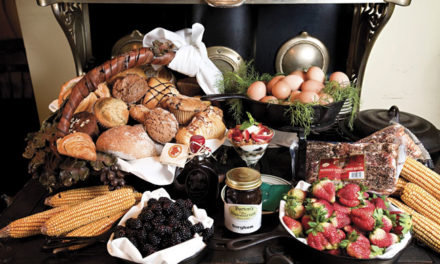BY PATRICK L. BAUDE
The commercial center of American wine 200 years ago was in southern Indiana around Vevay, on the Ohio River. Indiana’s early success was due to the cultivation of a grape called “Cape,” a hybrid of a flavorful European grape with a hardy North American vine. Although Indiana’s wine industry faded away in the 19th century, its renewed success was marked last year when the state officially recognized a promising new hybrid grape, the traminette, which makes “Indiana’s signature wine.”
Bloomington’s Oliver Winery was important in developing the quality of Indiana traminette. The grape itself is a result of crossing the internationally respected gewürztraminer, a spicy Alsatian wine grape usually made in a semi-dry style and often said to taste of litchi nuts, with a little-known grape called Joannes Seyve 23,416. The variety was created at the University of Illinois in 1965, as one of many efforts to produce vines with traditional flavors of old-world grapes combined with the ability to survive harsh Midwestern winters. Traminette wines produced in New York State, especially around the Finger Lakes, have met with some commercial success.
When Bill Oliver, president and director of winemaking at Oliver Winery, first planted the variety, he found the wine promising but with exaggerated, volatile flavors. He experimented with planting and winemaking techniques to let the clean fruit and spicy, floral notes dominate the resulting white wine. The finished product is a wine that won the “Indiana Traminette of the Year” award at the 2009 Indy International Wine Competition. Oliver suggests the wine would show well with a salad accented by fruit, especially blueberries, but above all he recommends it for “a sociable evening with friends.”
Twenty-one Indiana wineries now make traminettes. Their story and advice on traveling the “Traminette Trail” is online at tryontraminette.org. But for Bill and wife Kathleen, the bigger story is the growing success of one part of their operations, the Creekbend Vineyard. Since 1994 they have cultivated this special hilly site, its soil distinguished by fractured limestone and excellent drainage and its climate marked by good sun without excessive heat. They believe this terroir is “typical of the world’s great wine-growing areas” and have planted it with a range of grape varieties chosen to show its outstanding quality. Recognition for its traminette is only one step in Creekbend’s growing reputation.

















I do enjoy a good Traminette, and while Oliver is most definitely lovely I have also enjoyed Lanthier’s tram. It has a nice blend of fruity and just the right amount of sweetness to entertain about anyone’s taste buds. Props to OIiver and all the IN wineries premiering this extravagant grape!